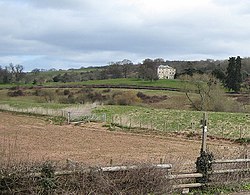Sufton Court
| Sufton Court | |
| Herefordshire | |
|---|---|
 Sufton Court across the lawns | |
| Location | |
| Grid reference: | SO57303794 |
| Location: | 52°2’18"N, 2°37’26"W |
| Village: | Mordiford |
| History | |
| Built 1788 | |
| For: | James Hereford by James Wyatt |
| Country house | |
| Information | |
| Owned by: | Private |
Sufton Court is a small, Palladian mansion by Mordiford in Herefordshire, set in extensive grounds looking out over the River Lugg and the River Wye, which join just below the bridge at Mordiford. The house has been since it was built the seat of the Hereford family and their descendants.[1][2]
The house was built in 1788 for James Hereford, an ancestor of the current family, in which James Wyatt was engaged as architect. Wyat is also responsible for the interiors, finest of which is the Music Room, now the Drawing Room.
The park was laid out by Humphry Repton.
The house is a Grade II* listed building.[3]
History
The Hereford family has been seated at Sufton from the 12th century. In the 1780s James Hereford commissioned a new house and, in 1795, a landscape park.
Until the house was built, the Herefords were seated at the house subsequently known as Old Sufton. In the 1780s James Hereford called in James Wyatt (1746-1813), to build a new house 450 yards to the south-west, on an elevated site with panoramic views west towards Hereford and with rising ground behind. That new house, at first called 'Sufton Place' but later 'Sufton Court'.
The house
The house was built in 1788, to the design of James Wyatt. It is built in bath stone ashlar, with a hipped stone slate roof. It has a double-depth plan with central entrance and stairwell.
There is a late 19th century cast iron porch.
The interior is largely intact, retaining fine ramped staircase, panelled doors some with inlay and main rooms with stuccoed ceiling decoration. Contemporary fireplaces have been retained too.[3]
The gardens
The gardens and grounds are themselves Grade II* listed.[4]
A landscaped park and grounds surround the house, to the extent of 30 acres: they were laid out following submission of a 'Red Book' by Humphry Repton in 1795, which book still survives.
The gardens give panoramic views to the west, across the Lugg Meadows to Hereford and to the Black Mountains beyond. Equally, the house is highly visible from approaches to the south; a strikingly good view of the house and park, for instance, is obtained from Mordiford Bridge, half a mile to the south-west.
Three of the four walls of the kitchen garden, which lay on southward-sloping ground a hundred yards north-east of the house, were demolished in the 1960s. The south wall, however, which forms the north wall of the gardens around the house, was retained.[4] The kitchen garden was already present when Repton came to Sufton in 1795, and was presumably constructed at the same time as the house.
Outside links
| ("Wikimedia Commons" has material about Sufton Court) |
- Sufton Court – The Historic Houses Association
References
- A Report on the Gardens at Sufton Court in ‘’The Field’’ 6 October 1894
- Taylor, H A : Trans Woolhope Naturalists Field Club 47, (1992), pp 210-36
- The Journal of the Picturesque Society 1, (1992) [transcription of, with commentary on, the Red Book] S Daniels and C Watkin, The Picturesque Landscape (1994), col pls VII, VIII, pp 82, 87 Garden History 22, (1994), pp 169-70
- ↑ 'Burke's and Savill's Guide to Country Houses', Volume II, p 60
- ↑ Robinson, J M : 'The Wyatts' (1979) p 245
- ↑ 3.0 3.1 National Heritage List 1179699: Sufton Court
- ↑ 4.0 4.1 National Heritage List 1000898: Sufton Court park and garden
